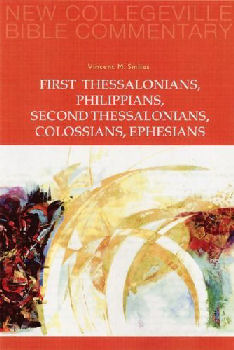
|
Posted February 21, 2006
Book: First Thessalonians, Philippians, Second Thessalonians, Colossians, Ephesians Author: Vincent M. Smiles Liturgical Press, Collegeville, MN, 2005, pp.125 An Excerpt from the Jacket:
In his clear and concise commentaries, Smiles reminds readers that these letters are very circumstantial, meaning that Paul composed them to respond to particular situations that he and his churches faced. An additional factor in understanding certain passages, especially 1 Thess 4:15-17, is Paul’s presumption that the end of human history was close at hand. He was wrong about this matteer just as those contemporary Christians are wrong who make so much of “the rupture” and the expected end of the world in our time. Readers very much in this world will appreciate Smile’s practical advice: “The best approach to the letters requires prayer, an open mind, and careful study both of their individuality and of the conversation, and sometimes vigorous debate, that together they represent.” An Excerpt from the Book: Ephesians 6:10-20 Final Exhortations In this final section the writer envisions Christian life as a great battle against “the evil spiritual powers that Christ defeated. The battle continues because believers are “flesh and blood,” the the evil they battle is not. Ultimately, in spite of 2:4-8, even Ephesians knows that the process of salvation is not yet complete. Therefore, especially through prayer believers need God’s “strength” and “armor” to withstand “the tactics of the devil”. “The evil day” is the tiem of “temptation” (“testing”) and “evil,” frm which we also pray to be delivered in the Lord’s Prayer. Drawing on Old Testament texts listing the weaponry of God (Isa 11:5; 59:16-17; Wis 5:16-23), the writer describes the (primary defensive armor that will see believers through the fight: “the girdle of truth,”“the breastplate of righteousness,” and so on (6:14-17). “The gospel of peace” might better be translated “the proclamation of peace,” meaning that believers must be “ready” to witness to the “peace” that God gives and thereby to “extinguish the flaming arrows” aimed at them (6:16). This passage, in other words might be a hint of some concern for defense of the gospel among non-believers. The only offensive weapon in the believer’s armor is “the sword of the Spirit, which is the word of God”; evangelization, that is, sharing the gospel, is part of the believer’s task. “The word” is not to be identified with the Bible or any part of it; “The word” is “alive and active” in and among believers. The Bible enables us to recognize “the word” but does not define it. It is for continued, vigorous sharing of “the mystery of the gospel” taht the writer asks the recipients to pray, as they also pray for themselves and “for all the holy ones”, that is, the church. The final reminder of Paul’s “imprisonment” keeps the great apostle’s memory present as the letter draws to a close. Table of Contents: The First Letter to the Thessalonians The Letter to the Philippians The Second Letter to the Thessalonians The Letter to the Colossians The Letter to Ephesians Review Aids and Discussion Topics Index of Citations from the Catechism of the Catholic Church |
|
